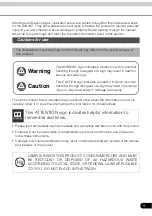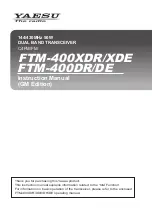
EN
EN
18
19
Tips for Getting the Most from your PowerSafe System
Flight Log
The optional Flight Log is highly recommended. The Flight Log can be used to test
the battery system using the built-in voltmeter and applying a load to the servos/
control surfaces. If a regulator is used the voltage should never drop below the
rated voltage (6.0 volts) even under a heavy load. When using direct batteries the
loaded voltage should never drop below 5.0 volts.
When the system is first installed it is highly recommend that an advanced range
check be performed. (See advanced range check on page 18.) If any receiver is
performing less than optimally (higher than normal fades) that receiver should be
repositioned and the advanced range test until low fades are recorded.
During first flights with sophisticated airplanes (significant conductive materials
onboard, many high-current draw servos, carbon construction, etc.), it’s a good
practice to keep your first flight in close then confirm
the RF link performance using the Flight Log to determine the performance of each
attached receiver. Extend the distance on subsequent flights
and record the Flight Log data confirming that all systems are
performing properly.
Storing Your System
If the system will be stored for more than two weeks, it’s important that the battery
be disconnected from the PowerSafe or from the regulator (if used). The PowerSafe
draws a small amount of current (less than 1mA) even when the switch is turned off
and the battery will drain and could become damaged if left attached for an exten-
ded period. This is especially important when using LiPo batteries as irreversible
damage could occur to your batteries.
Using Nickel-Metal Hydride Batteries
The latest generation of NiMH batteries incorporates a new chemistry mandated
to be more environmentally friendly. These batteries, when charged with peak
detection chargers have tendencies to false peak (not fully charge) repeatedly.
These include all brands of NiMH batteries. If using NiMH packs be especially
cautious when charging making absolutely sure that the battery is fully charged.
It is recommended that a fast charge with a meter that monitors the input mAh be
used and that the expected charge capacity is reached during charge.
2.4GHz Troubleshooting Guide
Problem
Possible Cause
Solution
Aircraft will not
“throttle up”but
all other controls
seem to function
User did not lower throttle
trim and throttle stick
prior to initializing the
aircraft
Lower throttle stick and
throttle trim to their lowest
settings
Throttle channel is
reversed. Futaba transmit-
ters (equipped with
Spektrum modules) may
require you to reverse the
throttle channel
Reverse throttle channel on
specific transmitter if
applicable
LED on aircraft
remains flashing
and cannot be
controlled by
transmitter
User did not wait at least
5 seconds after powering
the transmitter prior to
connecting the flight
battery to the aircraft
Unplug, then reconnect
flight battery
User bound the aircraft to
a different transmitter
Rebind aircraft to your
desired compatible
transmitter
Transmitter was too close
to aircraft during the
initialization process
Move transmitter (powered
on) a few feet from the
aircraft prior to reconnecting
the flight battery
Controls appear to
be reversed after
binding to a dif-
ferent transmitter
User did not initially set
up transmitter prior to
binding to the aircraft
See the “Advanced
Programming” section of
this manual
Aircraft does not
function after
connecting flight
battery and aircraft
smells burnt
User may have acciden-
tally plugged the flight
battery in with the wrong
polarity
Replace AR12120 board
and ensure the RED polarity
marks are facing the same
direction when
connecting the flight battery
to the AR12120 board
Содержание PowerSafe AR12120
Страница 13: ...EN 24 Steven A Hall Vice President International Operations and Risk Management Horizon Hobby Inc...
Страница 26: ...DE 48...
Страница 51: ......











































